Analysis of the Accessibility Improvement Index in Urban Areas through Heritage Buildings Used as Museums—Case Studies in the Region of Murcia (Spain)
Abstract
1. Introduction
- The design of a methodology for the study of the current and potential accessibility of buildings that does not negatively affect the heritage aspects of the building.
- The qualitative and quantitative study of the accessibility improvement index of a representative sample of musealised heritage buildings to obtain their current level of accessibility and their potential level of accessibility.
2. Object of Study
3. Materials and Methods
3.1. Phase 1: Building Documentation
- Architectural, historical, and artistic information about the building, including its history, heritage characteristics, displayed collections, etc.
- Functional information about the building. This includes activities conducted, schedules, types of visits (guided, self-guided…), information provided to users, resources for user accessibility, etc.
- Building plans to understand the layout and relationship between its spaces.
3.2. Phase 2: Accessibility Audit
3.3. Phase 3: Building Zoning and Assignment of Essential Qualities and Barriers
3.4. Phase 4: Determination of Current Accessibility Level (C.A.L.)
3.5. Phase 5: Study of Removable Barriers
- Eliminate the barrier for affected groups;
- Avoid creating new barriers for other groups;
- Avoid causing harm to the heritage building.
3.6. Phase 6: Determination of Potential Accessibility Level (P.A.L.)
3.7. Phase 7: Determination of Accessibility Improvement Index (A.I.I.)
- A.I.I.—accessibility improvement index;
- P.A.L.—potential accessibility level;
- C.A.L.—current accessibility level.
4. Results
5. Discussion
6. Conclusions
Author Contributions
Funding
Institutional Review Board Statement
Informed Consent Statement
Data Availability Statement
Acknowledgments
Conflicts of Interest
References
- Sustainable Development Goals. Available online: https://www.un.org/sustainabledevelopment/es/objetivos-de-desarrollo-sostenible/ (accessed on 15 July 2023).
- Goal 10: Reduce Inequality within and among Countries. Available online: https://www.un.org/sustainabledevelopment/es/inequality/ (accessed on 15 July 2023).
- Goal 11: Make Cities Inclusive, Safe, Resilient and Sustainable. Available online: https://www.un.org/sustainabledevelopment/es/cities/ (accessed on 15 July 2023).
- Retief, M.; Letšosa, R. Models of disability: A brief overview. HTS Theol. Stud. 2018, 74, a4738. [Google Scholar] [CrossRef]
- Zajadacz, A. Evolution of models of disability as a basis for further policy changes in accessible tourism. J. Tour. Futures 2015, 1, 189–202. [Google Scholar] [CrossRef]
- Velarde, V. Los modelos de la discapacidad: Un recorrido histórico. Rev. Empresa Y Humanismo 2012, 15, 115–136. [Google Scholar] [CrossRef]
- Clasificación Internacional del Funcionamiento, de la Discapacidad y de la Salud. Available online: https://apps.who.int/iris/bitstream/handle/10665/43360/9241545445_spa.pdf (accessed on 25 January 2020).
- Informe Mundial Sobre la Discapacidad. Available online: https://www.afro.who.int/sites/default/files/2017-06/9789240688230_spa.pdf (accessed on 25 January 2020).
- Instrumento de Ratificación de la Convención Sobre los Derechos de las Personas con Discapacidad, Hecho en Nueva York el 13 de Diciembre de 2006. Available online: https://www.boe.es/boe/dias/2008/04/21/pdfs/A20648-20659.pdf (accessed on 10 March 2020).
- Status of Ratification Interactive Dashboard. United Nations Human Rights. Available online: https://indicators.ohchr.org/ (accessed on 15 July 2023).
- Persson, H.; Åhman, H.; Yngling, A.A.; Gulliksen, J. Universal design, inclusive design, accessible design, design for all: Different concepts—One goal? On the concept of accessibility— historical, methodological and philosophical aspects. Univers. Access Inf. Soc. 2015, 14, 505–526. [Google Scholar] [CrossRef]
- Xiang, Z.R.; Zhi, J.Y.; Dong, S.Y.; Li, R.; He, S.J. The impacts of ergonomics/human factors of wheelchair/user combinations on effective barrier-free environments design: A case study of the Chinese universal rail coach layout. Int. J. Ind. Ergon. 2018, 67, 229–241. [Google Scholar] [CrossRef]
- Directive (EU) 2019/882 of the European Parliament and of the Council of 17 April 2019 on the Accessibility Requirements for Products and Services. Available online: http://data.europa.eu/eli/dir/2019/882/oj (accessed on 13 August 2020).
- Norma Española UNE 170001-1; Accesibilidad Universal. Criterios Generales de Diseño. AENOR: Madrid, Spain, 2007.
- Rebernik, N.; Szajczyk, M.; Bahillo, A.; Marusic, B.G. Measuring Disability Inclusion Performance in Cities Using Disability Inclusion Evaluation Tool (DIETool). Sustainability 2020, 12, 1378. [Google Scholar] [CrossRef]
- Telles, M.J.; Santos, R.; da Silva, J.M.; Righi, R.D.; Barbosa, J.L.V. An intelligent model to assist people with disabilities in smart cities. J. Ambient Intell. Smart Environ. 2021, 13, 301–324. [Google Scholar] [CrossRef]
- Wojtyszyn, B. Urban Solutions in the Universal Planning of Residential Spaces for the Elderly and the Disabled. Civ. Environ. Eng. Rep. 2022, 32, 72–95. [Google Scholar] [CrossRef]
- Setola, N.; Marzi, L.; Torricelli, M.C. Accessibility indicator for a trails network in a Nature Park as part of the environmental assessment framework. Environ. Impact Assess. Rev. 2018, 69, 1–15. [Google Scholar] [CrossRef]
- Park, J.; Chowdhury, S. Investigating the needs of people with disabilities to ride public transport routes involving transfers. J. Public Transp. 2022, 24, 100010. [Google Scholar] [CrossRef]
- Unsworth, C.A.; Chua, J.; Gudimetla, P.; Naweed, A. Powered mobility aid access on public transport: A validation study of compliance with disability standards. J. Transp. Health 2021, 22, 101093. [Google Scholar] [CrossRef]
- Perry, M.A.; Devan, H.; Fitzgerald, H.J.; Han, K.; Liu, L.; Rouse, J. Accessibility and usability of parks and playgrounds. Disabil. Health J. 2018, 11, 221–229. [Google Scholar] [CrossRef] [PubMed]
- Greco, A.; Giacometti, V. Accessibility and Social Sustainability: Assessment Tools for Urban Spaces and Buildings. In Proceedings of the PLEA 2013: Sustainable Architecture for a Renewable Future, Munich, Germany, 10–12 September 2013. [Google Scholar]
- Wazani, I.A.; Mohamad, D.; Jaafar, M. Accessibility for persons with disabilities in built environment of urban area: Case study of George Town, Penang. Plan. Malays. 2021, 19, 53–65. [Google Scholar] [CrossRef]
- Du, X.; Zhang, X.; Wang, H.; Zhi, X.; Huang, J. Assessing Green Space Potential Accessibility through Urban Artificial Building Data in Nanjing, China. Sustainability 2020, 12, 9935. [Google Scholar] [CrossRef]
- Jackson, M.A. Accessing the Neighbourhood: Built Environment Performance for People with Disability. AMPS: Archit. Media Politics Soc. 2019, 16, 4. [Google Scholar] [CrossRef]
- Fan, P.; Xu, L.; Yue, W.; Chen, J. Accessibility of public urban green space in an urban periphery: The case of Shanghai. Landsc. Urban Plan 2017, 165, 177–192. [Google Scholar] [CrossRef]
- Xiao, Y.; Wang, Z.; Tang, L.Z. An assessment of urban park access in Shanghai—Implications for the social equity in urban China. Landsc. Urban Plan 2017, 157, 383–393. [Google Scholar] [CrossRef]
- Attakora-Amaniampong, E.; Miller, A.W.; Tengan, C. All-inclusiveness and disability end-user satisfaction in student housing nexus: Cognitive dissonance perspective. Housing, Care Support 2022, 25, 107–121. [Google Scholar] [CrossRef]
- Goodwin, I.; Davis, E.; Winkler, D.; Douglas, J.; Wellecke, C.; D’Cruz, K.; Mulherin, P.; Liddicoat, S. Making homes more accessible for people with mobility impairment: A lived experience perspective. Aust. J. Soc. Issues 2022, 57, 956–969. [Google Scholar] [CrossRef]
- Wellecke, C.; D’Cruz, K.; Winkler, D.; Douglas, J.; Goodwin, I.; Davis, E.; Mulherin, P. Accessible design features and home modifications to improve physical housing accessibility: A mixed-methods survey of occupational therapists. Disabil. Health J. 2022, 15, 101281. [Google Scholar] [CrossRef]
- Burns, S.P.; Mendonca, R.; Pickens, N.D.; Smith, R.O. America’s housing affordability crisis: Perpetuating disparities among people with disability. Disabil. Soc. 2021, 36, 1719–1724. [Google Scholar] [CrossRef] [PubMed]
- Asante, L.A.; Sasu, A.; Gavu, E.K. Physical Access for Persons With Disability in Rented Compound Houses in Kumasi: Evidence From Selected Neighbourhoods in the Metropolis. Dev. Ctry. Stud. 2016, 6, 60–75. [Google Scholar] [CrossRef]
- Duman, U.; Uzunoğlu, K. The Importance of Universal Design for the Disabled in Public Buildings: A Public Building in Northern Cyprus as a Case Study. Civ. Eng. Archit. 2021, 9, 690–707. [Google Scholar] [CrossRef]
- Nischith, K.R.; Bhargava, M.; Akshaya, K.M. Physical accessibility audit of primary health centers for people with disabilities: An on-site assessment from Dakshina Kannada district in Southern India. J. Fam. Med. Prim. Care 2018, 7, 1300–1303. [Google Scholar] [CrossRef]
- Shapiro, D.; Pate, J.R.; Cottingham, M. A Multi-Institutional Review of College Campus Adapted Intramural Sports Programming for College Students with and without a Disability. Recreat. Sports J. 2020, 44, 109–125. [Google Scholar] [CrossRef]
- Carlsson, G.; Slaug, B.; Schmidt, S.M.; Norin, L.; Ronchi, E.; Gefenaite, G. A scoping review of public building accessibility. Disabil. Health J. 2022, 15, 101227. [Google Scholar] [CrossRef]
- Badji, S.; Badland, H.; Rachele, J.N.; Petrie, D. Public transport availability and healthcare use for Australian adults aged 18-60 years, with and without disabilities. J. Transp. Health 2021, 20, 101001. [Google Scholar] [CrossRef]
- Colmenero-Fonseca, F.; Fonce-Segura, C.D.; Guzman-Ramirez, A.; Flores-Garcia, M. Sustainable Public Transport Service Adapted for People with Disabilities and Reduced Mobility in the Municipality of Leon, Guanajuato, Mexico. Sustainability 2021, 13, 7471. [Google Scholar] [CrossRef]
- Gómez, Á.L. La accesibilidad para personas ciegas y con deficiencia visual al patrimonio cultural y natural. HerMus 2015, 1, 47–54. [Google Scholar]
- Convención Sobre la Protección del Patrimonio Mundial, Cultural y Natural. Available online: https://whc.unesco.org/archive/convention-es.pdf (accessed on 25 July 2023).
- Ley 4/2007, de 16 de Marzo, de Patrimonio Cultural de la Comunidad Autónoma de la Región de Murcia. Available online: https://www.boe.es/buscar/pdf/2008/BOE-A-2008-12526-consolidado.pdf (accessed on 7 June 2023).
- Ley 16/1985, de 25 de Junio, del Patrimonio Histórico Español. Available online: https://www.boe.es/buscar/act.php?id=BOE-A-1985-12534 (accessed on 26 August 2023).
- Jokanovic, M.B. Museum building as a museum object—biography of the 25th may museum in belgrade. Zb. Matice Srp. Za Likovne Umet. Matica Srp. J. Fine Arts 2021, 2021, 277–291. [Google Scholar] [CrossRef]
- Definición de Museo. Available online: https://icom.museum/es/recursos/normas-y-directrices/definicion-del-museo/ (accessed on 25 July 2023).
- ¿Qué es un Museo? Una Nueva Definición de Museo Para el Siglo XXI. Available online: https://www.sybariscollection.com/que-es-un-museo-una-nueva-definicion-de-museo-para-el-siglo-xxi/?lang=es (accessed on 26 August 2023).
- De Lapérouse, J.F. Ceramic musealization: How ceramics are conserved and the implications for research. Archaeol. Anthropol. Sci. 2019, 12, 166. [Google Scholar] [CrossRef]
- Bravo, F.G.Z. Musealization and management of territorial heritage: The Don Vasco Route in Michoacan, Mexico, and its interpretation center. Periplo Sustentable 2022, 43, 499–530. [Google Scholar]
- Zapletal, M. Musealization of Musical Instruments and its Theoretical Reflections from the 19th Century to the Present. Musicol. Brun. 2022, 57, 107–129. [Google Scholar] [CrossRef]
- Alvarez, C.A. y Eguren, M.G. Museums pedagogical: Didactic museums? Didáctica Cienc. Exp. Soc. 2011, 25, 103–116. [Google Scholar]
- Walker, H. Museum theory. Mus. Manag. Curatorship 2021, 36, 447–449. [Google Scholar] [CrossRef]
- Belyakova, M.P.; Winkels, K.; Turkin, A.N.; Filipenko, E.A. Mueum as an object of light design. Light Eng. 2023, 31, 66–70. [Google Scholar] [CrossRef]
- El Museo Nacional del Prado ha Recibido 2.456.724 Visitas en 2022. Available online: https://www.museodelprado.es/actualidad/noticia/el-museo-nacional-del-prado-ha-recibido-2456724/d86c5d55-9d4c-72d9-1771-df9d71774df0 (accessed on 25 July 2023).
- 7.8 million Visitors to the Musée du Louvre in 2022. Available online: https://presse.louvre.fr/7-8-million-visitors-to-the-musee-du-louvre-in-2022/ (accessed on 25 July 2023).
- The Met Welcomed More Than 7 Million Visitors in Fiscal Year 2019. Available online: https://www.metmuseum.org/press/news/2019/fy-2019-attendance (accessed on 25 July 2023).
- Museums and Galleries Monthly Visits. Available online: https://www.gov.uk/government/statistical-data-sets/museums-and-galleries-monthly-visits (accessed on 25 July 2023).
- Fortuna, J.; Harrison, C.; Eekhoff, A.; Marthaler, C.; Seromik, M.; Ogren, S.; VanderMolen, J. Identifying Barriers to Accessibility for Museum Visitors Who Are Blind and Visually Impaired. Visit. Stud. 2023. [Google Scholar] [CrossRef]
- Asakawa, S.; Guerreiro, J.; Ahmetovic, D.; Kitani, K.M.; Asakawa, C. The Present and Future of Museum Accessibility for People with Visual Impairments. In Proceedings of the 20th International ACM SIGACCESS Conference on Computers and Accessibility (ASSETS’18), New York, NY, USA, 22–24 October 2018. [Google Scholar]
- Mesquita, S.; Carneiro, M.J. Accessibility of European museums to visitors with visual impairments. Disabil. Soc. 2016, 31, 373–388. [Google Scholar] [CrossRef]
- Handa, K.; Dairoku, H.; Toriyama, Y. Investigation of priority needs in terms of museum service accessibility for visually impaired visitors. Br. J. Vis. Impair. 2010, 28, 221–234. [Google Scholar] [CrossRef]
- Vaz, R.; Freitas, D.; Coelho, A. Visiting Museums from the Perspective of Visually Impaired Visitors: Experiences and Accessibility Resources in Portuguese Museums. Int. J. Incl. Mus. 2021, 14, 71–93. [Google Scholar] [CrossRef]
- Gomes, B.; Romani, E.; Souza, A.; Liberalino, I. Communicational accessibility on science museums: Considerations on assistive technology. Humanidades Innovacao 2021, 8, 261–272. [Google Scholar]
- Kim, J.; Lee, C.; Kim, J.; Hong, J. Interactive description to enhance accessibility and experience of deaf and hard-of-hearing individuals in museums. Univ. Access Inf. Soc. 2023. [Google Scholar] [CrossRef] [PubMed]
- Münch, L.; Heuer, T.; Schiering, I.; Müller, S.V. Accessibility Criteria for an Inclusive Museum for People with Learning Disabilities: A Review. In Universal Access in Human-Computer Interaction. User and Context Diversity. HCII 2022. Lecture Notes in Computer Science; Antona, M., Stephanidis, C., Eds.; Springer: Cham, Switzerland, 2022; pp. 371–385. [Google Scholar]
- Reyes-Garcia, M.E.; Criado-Garcia, F.; Camunez-Ruiz, J.A.; Casado-Perez, M. Accessibility to Cultural Tourism: The Case of the Major Museums in the City of Seville. Sustainability 2021, 13, 3432. [Google Scholar] [CrossRef]
- Marconcini, S.; Pracchi, V. Inclusive cultural heritage sites: ICT as a tool to support the design process and share knowledge. The International Archives of the Photogrammetry, Remote Sensing and Spatial Information Sciences, Volume XLII-2/W11, 2019|GEORES 2019. In Proceedings of the 2nd International Conference of Geomatics and Restoration, Milan, Italy, 8–10 May 2019. [Google Scholar]
- Paladini, A.; Dhanda, A.; Reina Ortiz, M.; Weigert, A.; Nofal, E.; Min, A.; Gyi, M.; Su, S.; Van Balen, K.; Santana Quintero, M.; et al. Impact of Virtual Reality Experience on Accessibility of Cultural Heritage. In Proceedings of the 2nd International Conference of Geomatics and Restoration, Milan, Italy, 8–10 May 2019. [Google Scholar]
- Puyuelo, M.; Higón, J.L.; Merino, L.; Contero, M. Experiencing augmented reality as an accessibility resource in the unesco heritage site called “la lonja”, Valencia. Procedia Comput. Sci. 2013, 25, 171–178. [Google Scholar] [CrossRef]
- Tutal, O. Universal access in historic environment and accessibility of the Haci Hasan Mosque in Eskisehir. Int. J. Archit. Plan. 2018, 6, 126–141. [Google Scholar] [CrossRef]
- Vardia, S.; Khare, R.; Khare, A. Universal Access in Heritage Site: A Case Study on Jantar Mantar, Jaipur, India. Study Health Technol Inf. 2018, 256, 67–77. [Google Scholar]
- Biere, R.; Egusquiza Ortega, A. Herramienta para el diagnóstico de la accesibilidad en entornos de patrimonio histórico, en base a escaneado láser y realidad virtual: ACC3DE 1.0. ACE Archit. City Environ. 2010, 5, 61–90. [Google Scholar] [CrossRef]
- Naniopoulos, A. y Tsalis, P. A methodology for facing the accessibility of monuments developed and realised in Thessaloniki, Greece. J. Tour. Futures 2015, 1, 240–253. [Google Scholar] [CrossRef]
- Andrade, P.S. y Martins, L.B. Tactile reality: The perception of space in the cultural heritage for people with visual impairments. Procedia Manuf. 2015, 3, 6013–6019. [Google Scholar] [CrossRef][Green Version]
- Marín-Nicolás, J.; Sáez-Pérez, M.P. An evaluation tool for physical accessibility of cultural heritage buildings. Sustainability 2022, 14, 15251. [Google Scholar] [CrossRef]
- Mastrogiuseppe, M.; Span, S.; Bortolotti, E. Improving accessibility to cultural heritage for people with Intellectual Disabilities: A tool for observing the obstacles and facilitators for the access to knowledge. Alter 2021, 15, 113–123. [Google Scholar] [CrossRef]
- Marín-Nicolás, J.; Sáez-Pérez, M.P. Accesibilidad al patrimonio arquitectónico. Una herramienta para fomentar el turismo accessible. In IV Congreso Internacional de Tecnología y Turismo para la Diversidad. Libro de Comunicaciones TTD 2021; Fundación ONCE: Madrid, Spain, 2021; pp. 191–202. [Google Scholar]
- Zahari, N.F.; Che-Ani, A.I.; Abdul Rashid, R.B.; Mohd Tahir, M.A.; Amat, S. Factors contribute in development of the assessment framework for wheelchair accessibility in National Heritage Buildings in Malaysia. Int. J. Build. Pathol. Adapt. 2020, 38, 311–328. [Google Scholar] [CrossRef]
- Lynch, S.; Proverbs, D.G. How adaption of historic listed buildings affords access. Int. J. Build. Pathol. Adapt. 2020, 38, 76–86. [Google Scholar] [CrossRef]
- Garcés, M.A. Accesibilidad y patrimonio: Comentarios sobre la norma y los monumentos. ReCoPaR 2010, 7, 11–21. [Google Scholar] [CrossRef]
- Michopoulou, E.; Darcy, S.; Ambrose, I.; Buhalis, D. Accessible tourism futures: The world we dream to live in and the opportunities we hope to have. J. Tour. Futures 2015, 1, 179–188. [Google Scholar] [CrossRef]
- Piramanayagam, S.; Seal, P.P.; More, B. Inclusive hotel design in India: A user perspective. J. Access. Des. All 2019, 9, 41–65. [Google Scholar] [CrossRef]
- Rahim, A.A.; Samad, N.A.A. Accessible built environment for the elderly and disabled in Malaysia: Hotels as case studies. J. Constr. Dev. Ctries. 2010, 15, 1–21. [Google Scholar]
- Bashiti, A.; Rahim, A.A. A Study on the Accessibility in Shopping Malls for People with Disabilities (PWDS) in Malaysia. Int. J. Nat. Sci. Res. 2015, 3, 9–20. [Google Scholar] [CrossRef][Green Version]
- Hashim, A.E.; Samikon, S.A.; Ismail, F.; Kamarudin, H.; Jalil, M.N.M.; Arrif, N.M. Access and Accessibility Audit in Commercial Complex: Effectiveness in Respect to People with Disabilities (PWDs). Procedia Soc. Behav. Sci. 2012, 50, 452–461. [Google Scholar] [CrossRef]
- Marčeková, R.; Šebová, Ľ.; Pompurová, K.; Šimočková, I. Accessible tourism-current state in Slovakia. Entrep. Sustain. Issues 2021, 9, 66–86. [Google Scholar] [CrossRef]
- Hooi, P.M.; Yaacob, N.M. Accessibility for physically challenged persons in heritage buildings. J. Des. Built Environ. 2019, 19, 24–39. [Google Scholar] [CrossRef]
- Naniopoulos, A.; Tsalis, P.; Nalmpantis, D. An effort to develop accessible tourism in Greece and Turkey: The MEDRA project approach. J. Tour. Futures 2016, 2, 56–70. [Google Scholar] [CrossRef]
- Lista del Patrimonio Mundial. UNESCO. Available online: https://whc.unesco.org/es/list/ (accessed on 7 June 2023).
- Carta de Atenas. Available online: https://en.unesco.org/sites/default/files/guatemala_carta_de_atenas_1931_spa_orof.pdf (accessed on 7 June 2023).
- Carta del Restauro de Roma. Available online: https://www.portaenrere.cat/wp-content/uploads/2017/08/1932_Carta_Restauro_Roma.pdf (accessed on 13 January 2020).
- Carta de Venecia. Available online: https://www.icomos.org/images/DOCUMENTS/Charters/venice_sp.pdf (accessed on 13 January 2020).
- Carta de Quito. Available online: https://icomos.es/wp-content/uploads/2020/01/1967-carta-de-quito.pdf (accessed on 13 January 2020).
- Carta del Patrimonio Vernáculo Construido. Available online: https://icomos.es/wp-content/uploads/2020/01/8.CARTAPATRIMONIOVERNACULOCONSTRUIDO.pdf (accessed on 13 January 2020).
- Sawyer, A. Easy Access to Historic Buildings, 2nd ed.; English Heritage: Bedfordshire, UK, 2015; Available online: https://historicengland.org.uk/images-books/publications/easy-access-to-historic-buildings/heag010-easy-access-to-historic-buildings/ (accessed on 13 January 2022).
- De Medeiros, T.M.; Costa, K.N.d.F.M.; Da Costa, T.F.; Martins, K.P.; Dantas, T.R.A. Acessibilidade de pessoas com deficiência visual nos serviços de saúde. Rev. Enferm. 2017, 25, 11424. [Google Scholar] [CrossRef][Green Version]
- Lau, W.K.; Ho, D.C.W.; Yau, Y. Assessing the disability inclusiveness of university buildings in Hong Kong. Int. J. Strateg. Prop. Manag. 2016, 20, 184–197. [Google Scholar] [CrossRef]
- Keerthirathna, W.A.D.; Karunasena, G.; Rodrigo, V.A.K. Disability Access in Public Buildings. In Proceedings of the International Research Conference on Sustainability in Built Environment, 2010; pp. 94–104. Available online: https://www.researchgate.net/publication/324496984_Disability_Access_in_Public_Buildings (accessed on 13 January 2022).
- Stetieh, H. An evaluation of the school of engineering buildings at the university of Jordan with regard to accessibility. Sustain. Cities Soc. 2018, 42, 240–251. [Google Scholar] [CrossRef]
- Acioly, A.; Oliveira, M.; Freitas, V. Analysis of accessibility for buildings of a graduation school—an experiment in ergonomics training curriculum. Work 2012, 41, 4124–4129. [Google Scholar] [CrossRef]
- Jamaludin, M.; Abdul Kadir, S. Accessibility in Buildings of Tourist Attraction: A case studies comparison. Procedia Soc. Behav. Sci. 2012, 35, 97–104. [Google Scholar] [CrossRef]
- Wibawa, B.A.; Widiastuti, K. Evaluation of Accessibility with Wheelchairs Approach for Educational Buildings. In Proceedings of the 2nd International Conference on Education and Social Science Research (ICESRE 2019), Semarang, Indonesia, 19 October 2019. [Google Scholar] [CrossRef]
- Tudzi, E.; Bugri, J.; Ak, D. Human rights of students with disabilities in Ghana: Accessibility of the university built environment. Nord. J. Hum. Rights 2017, 35, 275–294. [Google Scholar] [CrossRef]
- Clemente, K.A.P.; Silva, S.V.; Vieira, G.I.; Bortoli, M.C.; Toma, T.S.; Ramos, V.D.; Brito, C.M.M. Barriers to the access of people with disabilities to health services: A scoping review. Rev. De Saúde Pública 2022, 56, 64. [Google Scholar] [CrossRef]
- Furtado de Lacerda Araújo, Y.; Silva Coura, A.; Satiro Xavier de França, I.; Queiroga Souto, T.; Araújo Rocha, M.; Chaves da Silva, J. Accessibility to basic health units for people with physical disabilities. Cogitare Enferm 2022, 27, e75651. [Google Scholar] [CrossRef]
- Groenewegen, P.; Kroneman, M.; Spreeuwenberg, P. Physical accessibility of primary care facilities for people with disabilities: A crosssectional survey in 31 countries. BMC Health Serv. Res. 2021, 21, 107. [Google Scholar] [CrossRef] [PubMed]
- Ketema, E.; Deribe, E. Accessibility of Commercial Buildings for Persons with Physical Difficulties in Addis Ababa. Landsc. Archit. Reg. Plan. 2022, 7, 34–42. [Google Scholar] [CrossRef]
- Zahari, N.F.; Harun, S.F.; Ahmad, N.A.; Zawawi, Z.A.; Salim, N.A.A. Comparative Analysis of Disabled Accessibility Needs of Heritage Building in Perak. In MATEC Web Conferences; EDP Sciences: Les Ulis, France, 2016; Volume 66, p. 00110. [Google Scholar] [CrossRef]
- Código Técnico de la Edificación. Documento Básico SUA. Seguridad de Utilización y Accesibilidad. Available online: https://www.codigotecnico.org/pdf/Documentos/SUA/DBSUA.pdf (accessed on 25 July 2023).
- Documento de Apoyo al Documento Básico DB-SUA Seguridad de Utilización y Accesibilidad. Código Técnico de la Edificación. Adecuación Efectiva de las Condiciones de Accesibilidad en Edificios Existentes. Available online: https://www.codigotecnico.org/pdf/Documentos/SUA/DA_SUA_2_Adecuacion.pdf (accessed on 25 July 2023).
- García-Quismondo, A. Modelado de un Sistema Inteligente de Ayuda a la Toma de Decisiones en la Evaluación de la Accesibilidad de Los Edificios. Ph.D. Thesis, Universidad de Alicante, Alicante, Spain, 2015. [Google Scholar]
- Cervera, S.J. Propuesta Metodológica de Análisis y Actuación de la Accesibilidad en los Municipios Rurales. El Caso Particular de la Marina Alta (Alicante). Ph.D. Thesis, Universidad Politécnica de Valencia, Valencia, Spain, 2016. [Google Scholar]
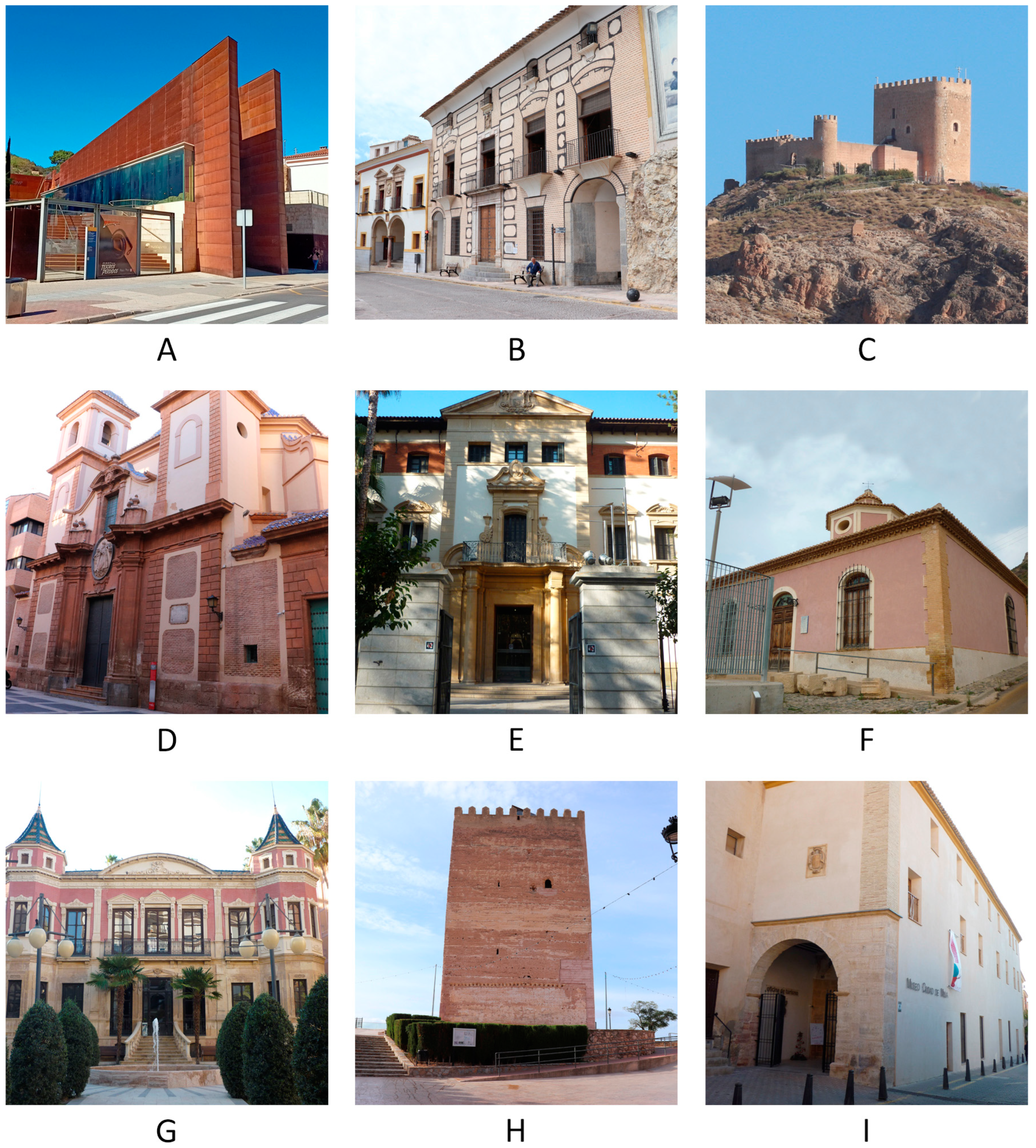
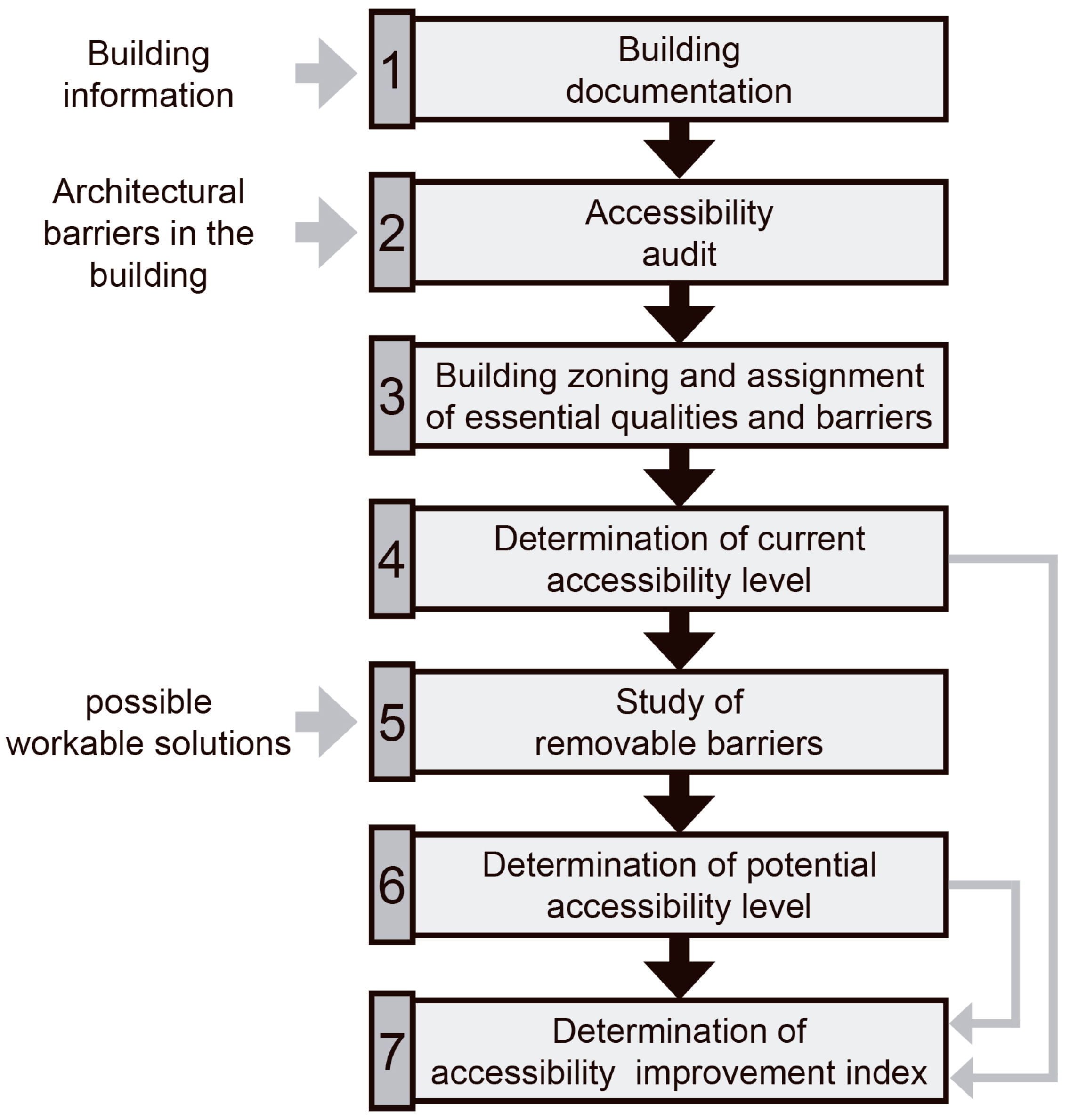

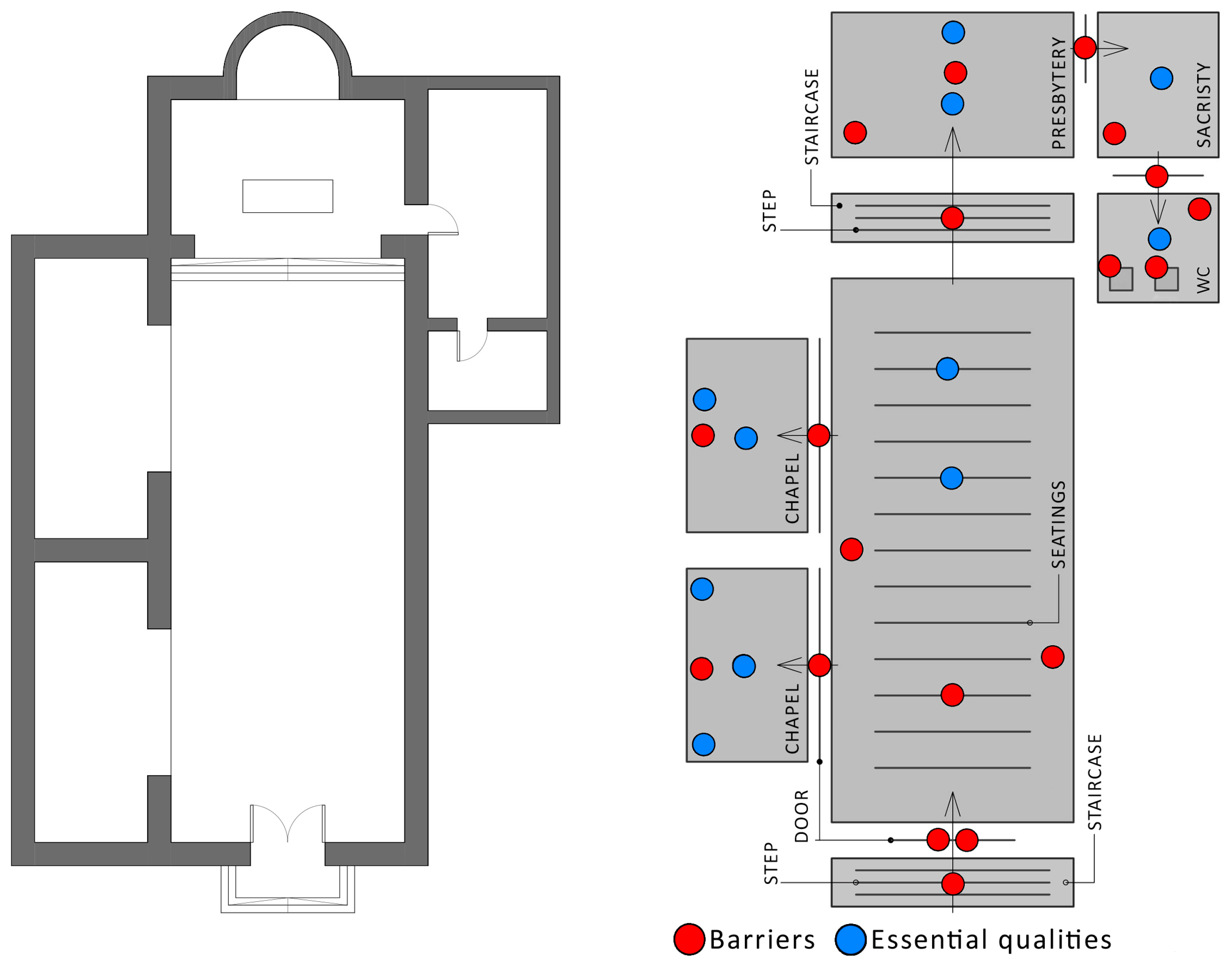
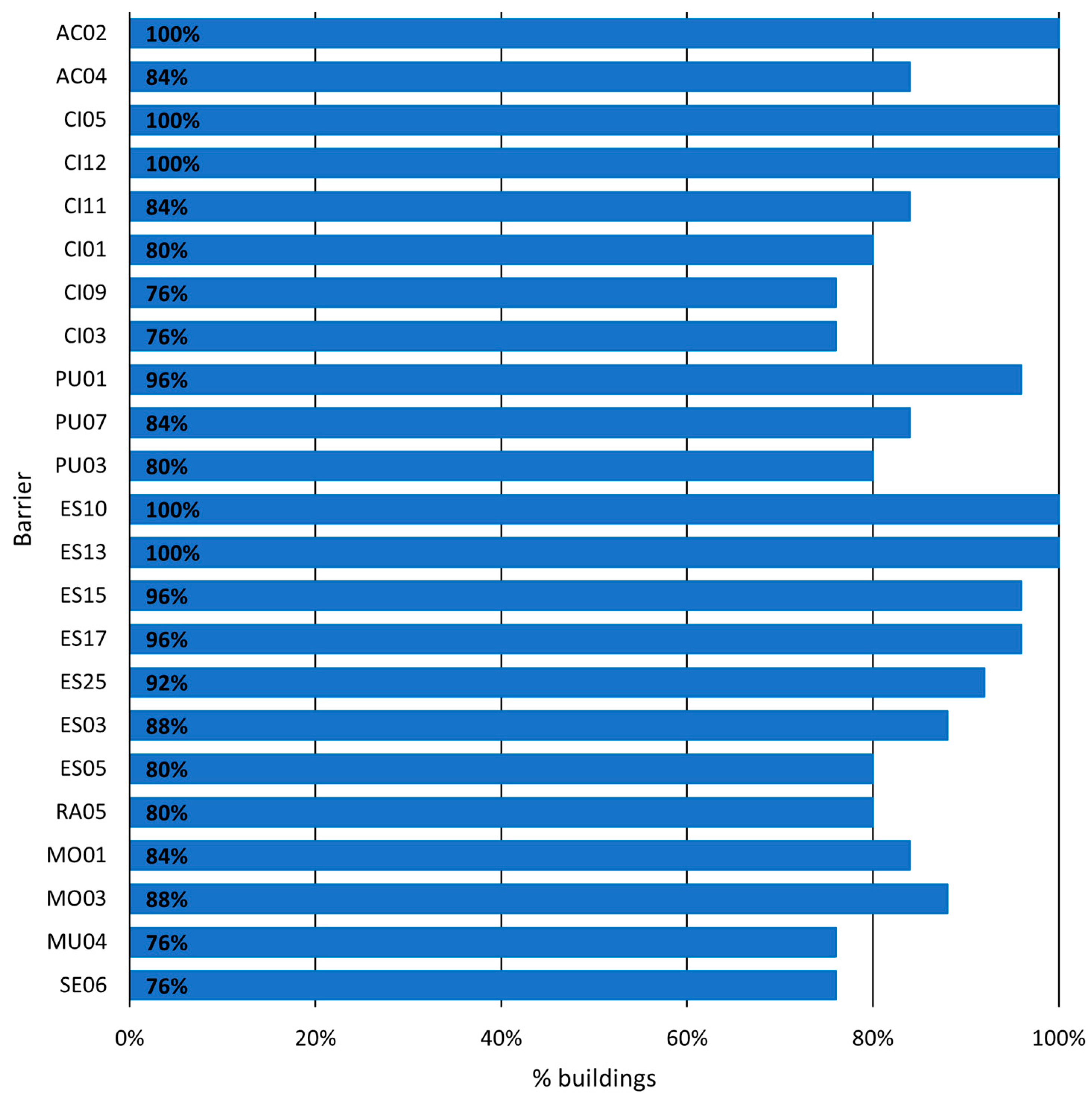
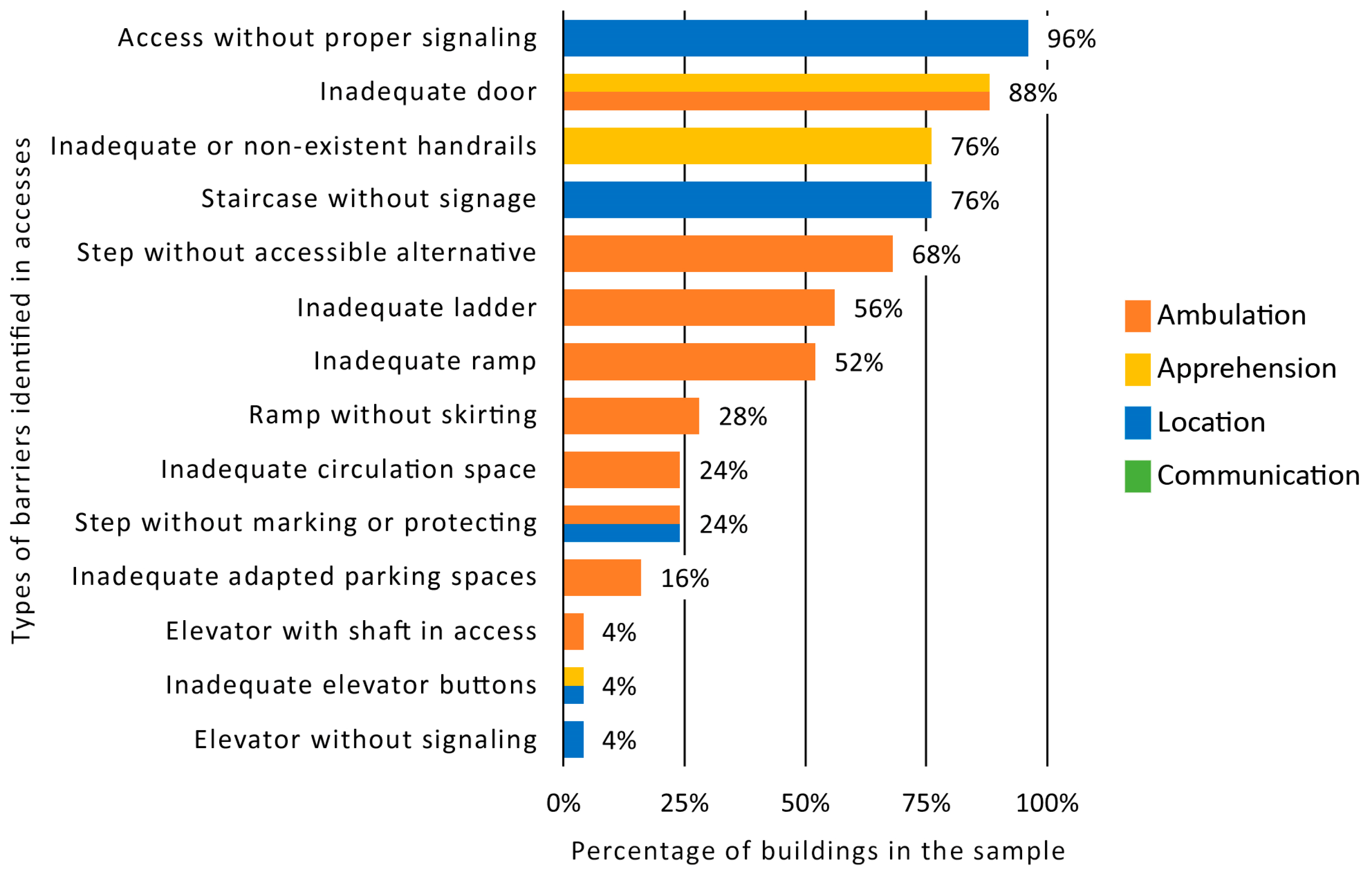
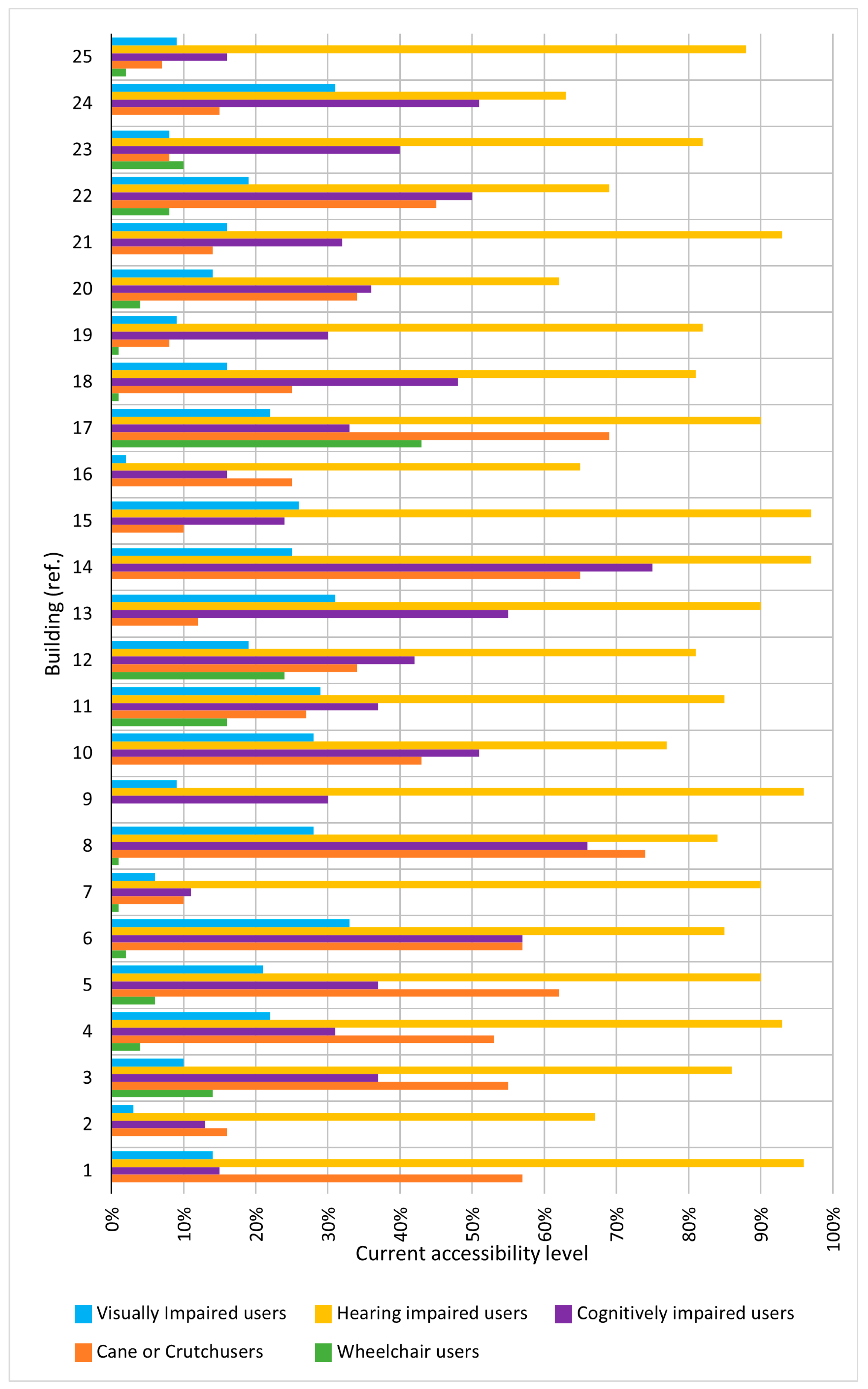
| Analysis Zone and Code | Catalogue Barriers |
|---|---|
| Parking space (AP) | 7 |
| Access (AC) | 5 |
| Door (PU) | 17 |
| Horizontal circulation (CI) | 12 |
| Flooring (PV) | 6 |
| Step with risk of falling (DE) | 6 |
| Information point (PA) | 8 |
| Staircase (ES) | 26 |
| Ramp (RA) | 23 |
| Lift (AS) | 24 |
| Escalator (EM) | 8 |
| Moving walkway (TR) | 7 |
| Step lift (PEV) | 12 |
| Stair lift (PEI) | 6 |
| Auditorium space (EA) | 10 |
| Furniture (MO) | 8 |
| Mechanisms (ME) | 3 |
| Wc (WC) | 29 |
| Signs (SE) | 12 |
| Musealisation (MU) | 9 |
| Barrier | Does Not Affect | Slightly Affects | Moderately Affects | Hinders Usage |
|---|---|---|---|---|
| Barrier 1 | C.L. = 0 | C.L. = 0.2 | C.L. = 0.5 | C.L. = 1 |
| % Accessible Essential Qualities | Level of Accessibility | Colour |
|---|---|---|
| 90% ≤ accessible essential qualities | Accessible | Green |
| 50% ≤ accessible essential qualities < 90% | Partially accessible | Yellow |
| Accessible essential qualities < 50% | Non-accessible | Red |
| Zone | Barrier | Solution | Technical Viability | Heritage Viability |
|---|---|---|---|---|
| Door | PUXX | PU-I01 | Assured | Awaiting |
| PU-I02 | Awaiting | Assured | ||
| PU-I23 | Assured | Assured |
| Zone | Barrier | Description | % Buildings |
|---|---|---|---|
| Access | AC02 | Access without accessibility signage | 100% |
| AC04 | Access without accessible directory | 84% | |
| Horizontal circulation | CI05 | Undetectable obstacle | 100% |
| CI12 | Isolated step with no accessible alternative | 100% | |
| CI11 | There is no accessible vertical communication | 84% | |
| CI01 | Width < 1.20 m | 80% | |
| CI09 | Insufficient lighting | 76% | |
| CI03 | Height < 2.20 m | 76% | |
| Door | PU01 | Width < 0.80 m | 96% |
| PU07 | Insufficient clearance between door and mechanism | 84% | |
| PU03 | Door without turning space | 80% | |
| Staircase | ES10 | Step without edge signalling | 100% |
| ES13 | Stair landings without signalling | 100% | |
| ES15 | Staircase without continuous handrail | 96% | |
| ES17 | Short handrail ends | 96% | |
| ES25 | Handrails without braille orientation plates | 92% | |
| ES03 | Width < 1.20 m | 88% | |
| ES05 | Inadequate step height | 80% | |
| Ramp | RA05 | Excessive longitudinal slope | 80% |
| Furniture | MO01 | Insufficient provision of accessible seats | 84% |
| MO03 | Armless seat | 88% | |
| Musealisation | MU04 | Element exposed at elevated height or on the ceiling | 76% |
| Signs | SE06 | The signal produces reflections | 76% |
| Building (Ref) | Current Accessibility Level (C.A.L.) | ||||
|---|---|---|---|---|---|
| Wheelchair Users | Cane or Crutch Users | Cognitively Impaired Users | Hearing Impaired Users | Visually Impaired Users | |
| 01 | 2% | 7% | 16% | 88% | 9% |
| 02 | 0% | 15% | 51% | 63% | 31% |
| 03 | 10% | 8% | 40% | 82% | 8% |
| 04 | 8% | 45% | 50% | 69% | 19% |
| 05 | 0% | 14% | 32% | 93% | 16% |
| 06 | 4% | 34% | 36% | 62% | 14% |
| 07 | 1% | 8% | 30% | 82% | 9% |
| 08 | 1% | 25% | 48% | 81% | 16% |
| 09 | 43% | 69% | 33% | 90% | 22% |
| 10 | 0% | 25% | 16% | 65% | 2% |
| 11 | 0% | 10% | 24% | 97% | 26% |
| 12 | 0% | 65% | 75% | 97% | 25% |
| 13 | 0% | 12% | 55% | 90% | 31% |
| 14 | 24% | 34% | 42% | 81% | 19% |
| 15 | 16% | 27% | 37% | 85% | 29% |
| 16 | 0% | 43% | 51% | 77% | 28% |
| 17 | 0% | 0% | 30% | 96% | 9% |
| 18 | 1% | 74% | 66% | 84% | 28% |
| 19 | 1% | 10% | 11% | 90% | 6% |
| 20 | 2% | 57% | 57% | 85% | 33% |
| 21 | 6% | 62% | 37% | 90% | 21% |
| 22 | 4% | 53% | 31% | 93% | 22% |
| 23 | 14% | 55% | 37% | 86% | 10% |
| 24 | 0% | 16% | 13% | 67% | 3% |
| 25 | 0% | 57% | 15% | 96% | 14% |
| Average | 6% | 33% | 37% | 84% | 18% |
| Standard deviation | 10% | 23% | 17% | 11% | 9% |
| Building (Ref) | Wheelchair Users | Cane or Crutch Users | Cognitively Impaired Users | Hearing Impaired Users | Visually Impaired Users | |||||
| C.A.L. | P.A.L. | C.A.L. | P.A.L. | C.A.L. | P.A.L. | C.A.L. | P.A.L. | C.A.L. | P.A.L. | |
| 01 | 2% | 14% | 7% | 14% | 16% | 100% | 88% | 100% | 9% | 99% |
| 02 | 0% | 45% | 15% | 47% | 51% | 99% | 63% | 100% | 31% | 98% |
| 03 | 10% | 33% | 8% | 32% | 40% | 100% | 82% | 100% | 8% | 99% |
| 04 | 8% | 39% | 45% | 98% | 50% | 100% | 69% | 100% | 19% | 95% |
| 05 | 0% | 83% | 14% | 99% | 32% | 100% | 93% | 100% | 16% | 100% |
| 06 | 4% | 98% | 34% | 99% | 36% | 100% | 62% | 100% | 14% | 99% |
| 07 | 1% | 89% | 8% | 89% | 30% | 100% | 82% | 100% | 9% | 100% |
| 08 | 1% | 50% | 25% | 58% | 48% | 100% | 81% | 100% | 16% | 90% |
| 09 | 43% | 84% | 69% | 97% | 33% | 100% | 90% | 100% | 22% | 96% |
| 10 | 0% | 87% | 25% | 77% | 16% | 100% | 65% | 100% | 2% | 99% |
| 11 | 0% | 63% | 10% | 94% | 24% | 100% | 97% | 100% | 26% | 97% |
| 12 | 0% | 0% | 65% | 87% | 75% | 100% | 97% | 100% | 25% | 98% |
| 13 | 0% | 34% | 12% | 41% | 55% | 100% | 90% | 100% | 31% | 98% |
| 14 | 24% | 95% | 34% | 93% | 42% | 100% | 81% | 100% | 19% | 93% |
| 15 | 16% | 36% | 27% | 89% | 37% | 99% | 85% | 100% | 29% | 96% |
| 16 | 0% | 57% | 43% | 57% | 51% | 96% | 77% | 100% | 28% | 96% |
| 17 | 0% | 31% | 0% | 32% | 30% | 94% | 96% | 100% | 9% | 87% |
| 18 | 1% | 96% | 74% | 100% | 66% | 100% | 84% | 100% | 28% | 100% |
| 19 | 1% | 54% | 10% | 56% | 11% | 100% | 90% | 100% | 6% | 98% |
| 20 | 2% | 98% | 57% | 100% | 57% | 100% | 85% | 100% | 33% | 99% |
| 21 | 6% | 88% | 62% | 100% | 37% | 100% | 90% | 100% | 21% | 100% |
| 22 | 4% | 91% | 53% | 93% | 31% | 100% | 93% | 100% | 22% | 100% |
| 23 | 14% | 78% | 55% | 98% | 37% | 100% | 86% | 100% | 10% | 98% |
| 24 | 0% | 67% | 16% | 73% | 13% | 100% | 67% | 97% | 3% | 63% |
| 25 | 0% | 100% | 57% | 100% | 15% | 100% | 96% | 100% | 14% | 100% |
| Average | 6% | 64% | 33% | 77% | 37% | 99% | 84% | 100% | 18% | 96% |
| Standard deviation | 10% | 29% | 23% | 27% | 17% | 1% | 11% | 1% | 9% | 8% |
| Building (Ref) | Existing Barriers | Removable Barriers | Accessibility Improvement Index (A.I.I.) | ||||
| Wheelchair Users | Cane or Crutch Users | Cognitively Impaired Users | Hearing Impaired Users | Visually Impaired Users | |||
| 01 | 408 | 89% | 12% | 7% | 84% | 12% | 90% |
| 02 | 132 | 93% | 45% | 32% | 48% | 37% | 67% |
| 03 | 150 | 93% | 23% | 23% | 60% | 18% | 91% |
| 04 | 244 | 91% | 31% | 53% | 50% | 31% | 75% |
| 05 | 153 | 93% | 83% | 85% | 68% | 7% | 84% |
| 06 | 278 | 95% | 95% | 65% | 64% | 38% | 85% |
| 07 | 256 | 94% | 87% | 81% | 70% | 18% | 91% |
| 08 | 177 | 89% | 49% | 33% | 52% | 19% | 74% |
| 09 | 336 | 86% | 41% | 28% | 67% | 10% | 74% |
| 10 | 178 | 96% | 87% | 52% | 84% | 35% | 97% |
| 11 | 360 | 94% | 63% | 85% | 76% | 3% | 71% |
| 12 | 94 | 90% | 0% | 22% | 25% | 3% | 73% |
| 13 | 243 | 85% | 34% | 30% | 45% | 10% | 67% |
| 14 | 202 | 89% | 71% | 59% | 57% | 19% | 74% |
| 15 | 312 | 91% | 20% | 62% | 62% | 15% | 66% |
| 16 | 85 | 85% | 57% | 14% | 44% | 23% | 67% |
| 17 | 223 | 78% | 31% | 32% | 64% | 4% | 78% |
| 18 | 308 | 99% | 95% | 26% | 34% | 16% | 72% |
| 19 | 258 | 92% | 53% | 46% | 89% | 10% | 92% |
| 20 | 414 | 97% | 95% | 42% | 43% | 15% | 66% |
| 21 | 540 | 98% | 82% | 38% | 63% | 10% | 79% |
| 22 | 196 | 92% | 87% | 39% | 69% | 7% | 78% |
| 23 | 471 | 89% | 64% | 43% | 63% | 14% | 88% |
| 24 | 456 | 86% | 67% | 57% | 87% | 30% | 60% |
| 25 | 90 | 100% | 100% | 43% | 85% | 4% | 86% |
| Average | N/A | 91% | 59% | 44% | 62% | 16% | 78% |
| Standard deviation | N/A | 5% | 29% | 21% | 17% | 11% | 10% |
Disclaimer/Publisher’s Note: The statements, opinions and data contained in all publications are solely those of the individual author(s) and contributor(s) and not of MDPI and/or the editor(s). MDPI and/or the editor(s) disclaim responsibility for any injury to people or property resulting from any ideas, methods, instructions or products referred to in the content. |
© 2023 by the authors. Licensee MDPI, Basel, Switzerland. This article is an open access article distributed under the terms and conditions of the Creative Commons Attribution (CC BY) license (https://creativecommons.org/licenses/by/4.0/).
Share and Cite
Marín-Nicolás, J.; Sáez-Pérez, M.P.; Tajani, F.; Sica, F. Analysis of the Accessibility Improvement Index in Urban Areas through Heritage Buildings Used as Museums—Case Studies in the Region of Murcia (Spain). Sustainability 2023, 15, 13517. https://doi.org/10.3390/su151813517
Marín-Nicolás J, Sáez-Pérez MP, Tajani F, Sica F. Analysis of the Accessibility Improvement Index in Urban Areas through Heritage Buildings Used as Museums—Case Studies in the Region of Murcia (Spain). Sustainability. 2023; 15(18):13517. https://doi.org/10.3390/su151813517
Chicago/Turabian StyleMarín-Nicolás, José, Mª Paz Sáez-Pérez, Francesco Tajani, and Francesco Sica. 2023. "Analysis of the Accessibility Improvement Index in Urban Areas through Heritage Buildings Used as Museums—Case Studies in the Region of Murcia (Spain)" Sustainability 15, no. 18: 13517. https://doi.org/10.3390/su151813517
APA StyleMarín-Nicolás, J., Sáez-Pérez, M. P., Tajani, F., & Sica, F. (2023). Analysis of the Accessibility Improvement Index in Urban Areas through Heritage Buildings Used as Museums—Case Studies in the Region of Murcia (Spain). Sustainability, 15(18), 13517. https://doi.org/10.3390/su151813517









